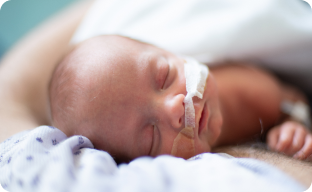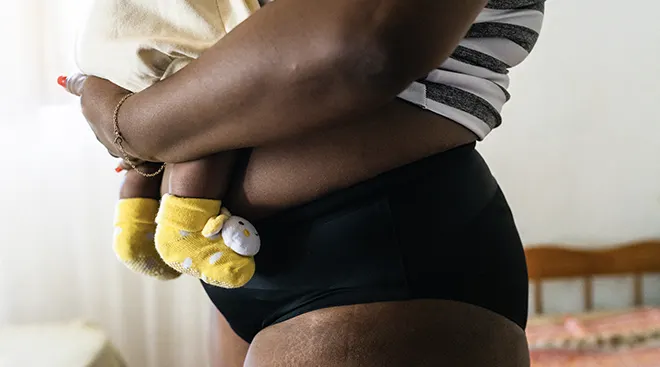Why It's Called a "Mother's Apron" or Postpartum Apron Belly (and What to Do About It)
Between a still-shrinking uterus and the baby weight, most brand-new moms aren’t wearing their pre-pregnancy jeans quite yet. Fortunately, our expectations of postpartum weight loss have evolved, partially thanks to social media serving up more realistic portrayals of what a postpartum belly actually looks like. But it’s still completely normal to struggle with a sagging, squishy stomach—which can look like an “apron belly” for some moms.
A postpartum apron belly isn’t unusual at all, whether you had a vaginal delivery or C-section. After all, you did just give birth to a human roughly the size of a watermelon. “I’ve had to reframe how I think about myself,” shares The Bump community member Court11152325. “I’ve been finding new things about myself that I like. I have a pregnancy apron, but my body grew a human and is now feeding it. That’s pretty awesome.”
Read ahead for everything you need to know about your so-called “mother’s apron,” including ideas for apron belly exercises to minimize it (gradually, and with acceptance and patience!).
- A postpartum apron belly is the result of the weight gain and physical changes caused by pregnancy, followed by giving birth.
- Core exercises and other lifestyle changes can minimize the appearance of an apron belly.
- Your postpartum apron belly is completely normal, and you don’t have to do anything to change it unless you want to.
An apron belly—aka mother’s apron or pannus—is the excess skin and fat tissue that hangs down in front of your stomach, often extending over your bikini line, after giving birth. Because of where and how it hangs, this skin resembles an apron.
Between weight gain and physical changes that cause abdominal stretching during pregnancy, it makes sense that the postpartum period would leave many women looking down at an apron belly. After all, you’ve just lost a lot of weight pretty quickly. “After pregnancy, the body undergoes normal changes in the skin and tissue of the belly that can lead to more stretching or loose tissue as the body heals after delivery,” explains Victoria Petruzzi, MD, an ob-gyn at Houston Methodist Willowbrook Hospital in Texas.
Another pregnancy-related cause of apron belly is diastasis recti, or separation of the vertical abdominal muscles because of the increased pressure on them as the uterus grows. This can make an apron belly more noticeable, since the muscles are overstretched and sag away from the center of your stomach.
According to both Nyrene Buford, PT, DPT, and Hannah Rohde, PT, DPT, women’s health specialists at HIDEF Physical Therapy in Washington state, certain factors can make you more likely to develop an apron belly after birth. These include age, high weight gain during pregnancy, lack of exercise and having previously given birth.
I think it’s harder for me this time around because I know how long it took to get my tummy back to not being huge last time. I have a zillion stretch marks and a pregnancy apron. Two C-sections less than two years apart. I guess that's what I get, plus two super-cute little dudes!
There’s no single trick for getting rid of your apron belly, but there are things you can do to help minimize its appearance:
- A healthy lifestyle. Any activities that improve muscle tone and reduce belly fat can improve an apron belly, says Tania Lopez, CNM, a certified nurse-midwife at Pediatrix Medical Group in Texas. This includes eating healthy foods, exercising 30 minutes every day, strength training and getting enough sleep, she explains. Just make sure you’ve been cleared to exercise postpartum, says Petruzzi.
- Wearing a belly band. According to Buford and Rohde, compression garments like belly bands can be useful on a short-term basis to support you while you work on strengthening your core. Just don’t over-rely on them, they warn: You want to eventually build a strong enough core to not need these garments anymore.
- Seeing a physical therapist. Improving your core isn’t a magic cure for an apron belly, but if yours is caused by diastasis recti, specialized diastasis recti exercises can help you tighten up the abdominal muscles that have been overstretched. However, every postpartum body is different and many women need a customized approach to their routine. It’s a good idea to consult with a physical therapist before deciding which exercises to focus on.
If the appearance of your belly is having a negative effect on your quality of life, you might consider surgery at some point. You have two options, says Petruzzi: a panniculectomy, which removes the excess skin and fat, and a tummy tuck (or abdominoplasty), which both removes excess skin and fat and tightens the abdominal wall muscles for added shaping and contouring. Your healthcare provider can help you figure out which surgery is best for your anatomy and future pregnancy plans, says Petruzzi.
Buford and Rohde say any consistent exercise routine is good for minimizing apron belly, but a combination of exercises that strengthen your core, improve your posture and blend weight-lifting with cardio is best.
They recommend the following beginner-friendly apron belly exercises to start with:
- Any plank variation. Lie on your stomach with your forearms flat on the floor and your elbows aligned under your shoulders. Lift up on your toes while keeping your back straight. Try to hold this position for at least 30 seconds.
- Hollow hold. Lie on your back and extend your arms overhead while lifting both legs a few inches off the floor. Keep your lower back pressed against the floor. Try to hold it for around 30 seconds.
- Any dead bug variation. Lie on your back with your arms extended toward the ceiling and your knees bent at a 90-degree angle. Lower one leg to the ground while raising the opposite arm straight down over your head, then return to start and repeat with the opposite arm and leg.
- Diaphragmatic breathing. Sit or lie down in any comfortable position. Inhale through your nose and exhale through your mouth while making sure your diaphragm, or core, is doing the work to help you breathe (you can keep your hand on your belly to feel it rising and falling with each breath).
Some of these, like diaphragmatic breathing, are also exercises recommended for women trying to heal diastasis recti, allowing you to address more than one cause of apron belly at once.
Frequently Asked Questions
Are there risk factors for a mother’s apron belly?
A small apron belly can be a normal part of a postpartum body, says Petruzzi, especially if you just have a little excess skin. But if your apron belly is associated with being overweight or obese, Petruzzi says it can increase your risk for other chronic health conditions like diabetes or hypertension. According to the Mayo Clinic, excess belly fat in women also increases your risk of high cholesterol, sleep apnea, heart disease and stroke.
Having a lot of excess skin, with or without belly fat, can also cause complications, says Lopez: “It's a spot that can become irritated or infected because of excess sweat, so it’s important to lift the excess skin to clean and dry the area to prevent skin conditions.”
Why is an apron belly so stubborn?
There are several factors that contribute to an apron belly, say Buford and Rohde, like your skin’s elasticity, your genetics and whether you have diastasis recti. These factors can also make it easier or harder to minimize the appearance of an apron belly through lifestyle changes alone.
Because the skin is so stretched, says Lopez, sometimes even core exercises can’t tone it, especially when you lose weight quickly, like after delivery.
Is an apron belly the same as a C-section shelf?
No. The two look similar, says Lopez, and both can be made worse by increased body fat or excess abdominal skin, but they have different causes: An apron belly is caused by the lower part of the abdomen stretching and sagging downward, while a C-section shelf is caused specifically by the scar created by a cesarean section.
“[When a cesarean scar] causes a distinct break in the skin of the lower abdomen, near the top of the pubic area, it can cause the excess skin at the top of the scar to fold over the incision and create a shelf-like appearance,” Lopez explains.
How does cortisol affect the apron belly appearance?
High cortisol levels can make an apron belly look more pronounced. Cortisol is a naturally occurring hormone that comes mainly from the adrenal glands, explains Lopez. It helps with many important functions in the body, including our stress response, metabolism, bone growth, immune system and blood pressure. High cortisol levels, caused by stress and lack of sleep, can lead to overeating and also independently trigger weight gain, especially in the abdomen.
A postpartum apron belly is a combination of excess skin and fat caused by giving birth. There’s no quick way to fix it (unless you commit to surgery)—the best approach is through seeing a physical therapist, doing core exercises and generally living a healthy lifestyle.
Keep in mind that no one’s body goes totally back to “normal” after birth, and your postpartum body reflects the intense physical and emotional journey of going through pregnancy and delivery. That said, if your apron belly is having a negative impact on your health or self-esteem, make sure to speak to a healthcare provider.
Please note: The Bump and the materials and information it contains are not intended to, and do not constitute, medical or other health advice or diagnosis and should not be used as such. You should always consult with a qualified physician or health professional about your specific circumstances.
Plus, more from the Bump:
Nyrene Buford, PT, DPT, is a physical therapist and the Covington director at HIDEF Physical Therapy in Washington state.
Tania Lopez, CNM, is a certified nurse-midwife at Pediatrix Medical Group in Texas.
Victoria Petruzzi, MD, is an ob-gyn at Houston Methodist Willowbrook Hospital in Texas. She earned her medical degree from University of Texas Medical Branch at Galveston.
Hannah Rohde, PT, DPT, OCS, SCS, is a physical therapist and the Bellevue clinic director at HIDEF Physical Therapy in Washington state. She specializes in orthopedics, sports and pelvic health.
Mayo Clinic, Belly Fat in Women: Taking—and Keeping—It Off, June 2023
Real-parent perspectives:
Learn how we ensure the accuracy of our content through our editorial and medical review process
Navigate forward to interact with the calendar and select a date. Press the question mark key to get the keyboard shortcuts for changing dates.






















































